Seaborn分布数据可视化---散点分布图
散点分布图
综合表示散点图和直方分布图。
Jointplot()
绘制二变量或单变量的图形,底层是JointGrid()。
sns.jointplot(
x,
y,
data=None,
kind='scatter',
stat_func=None,
color=None,
height=6,
ratio=5,
space=0.2,
dropna=True,
xlim=None,
ylim=None,
joint_kws=None,
marginal_kws=None,
annot_kws=None,
**kwargs,
)
Docstring:
Draw a plot of two variables with bivariate and univariate graphs.
This function provides a convenient interface to the :class:`JointGrid`
class, with several canned plot kinds. This is intended to be a fairly
lightweight wrapper; if you need more flexibility, you should use
:class:`JointGrid` directly.
Parameters
----------
x, y : strings or vectors
Data or names of variables in ``data``.
data : DataFrame, optional
DataFrame when ``x`` and ``y`` are variable names.
kind : { "scatter" | "reg" | "resid" | "kde" | "hex" }, optional
Kind of plot to draw.
stat_func : callable or None, optional
*Deprecated*
color : matplotlib color, optional
Color used for the plot elements.
height : numeric, optional
Size of the figure (it will be square).
ratio : numeric, optional
Ratio of joint axes height to marginal axes height.
space : numeric, optional
Space between the joint and marginal axes
dropna : bool, optional
If True, remove observations that are missing from ``x`` and ``y``.
{x, y}lim : two-tuples, optional
Axis limits to set before plotting.
{joint, marginal, annot}_kws : dicts, optional
Additional keyword arguments for the plot components.
kwargs : key, value pairings
Additional keyword arguments are passed to the function used to
draw the plot on the joint Axes, superseding items in the
``joint_kws`` dictionary.
Returns
-------
grid : :class:`JointGrid`
:class:`JointGrid` object with the plot on it.
See Also
--------
JointGrid : The Grid class used for drawing this plot. Use it directly if
you need more flexibility.
#综合散点分布图-jointplot
#创建DataFrame数组
rs = np.random.RandomState(3)
df = pd.DataFrame(rs.randn(200,2), columns=['A','B'])
#绘制综合散点分布图jointplot()
sns.jointplot(x=df['A'], y=df['B'], #设置x和y轴的数据
data=df, #设置数据
color='k',
s=50, edgecolor='w', linewidth=1, #散点大小、边缘线颜色和宽度(只针对scatter)
kind='scatter', #默认类型:“scatter”,其他有“reg”、“resid”、“kde”
space=0.2, #设置散点图和布局图的间距
height=8, #图表的大小(自动调整为正方形)
ratio=5, #散点图与布局图高度比率
stat_func= sci.pearsonr, #pearson相关系数
marginal_kws=dict(bins=15, rug=True)) #边际图的参数
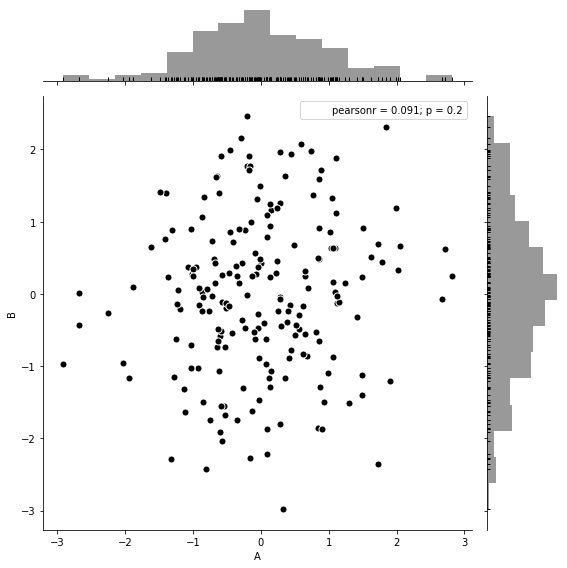
sns.jointplot(x=df['A'], y=df['B'],
data=df,
color='k',
kind='reg', #reg添加线性回归线
height=8,
ratio=5,
stat_func= sci.pearsonr,
marginal_kws=dict(bins=15, rug=True))
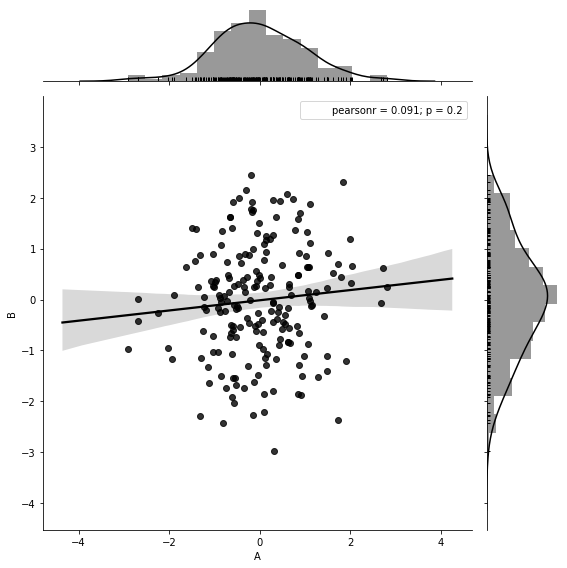
sns.jointplot(x=df['A'], y=df['B'],
data=df,
color='k',
kind='resid', #resid
height=8,
ratio=5,
marginal_kws=dict(bins=15, rug=True))
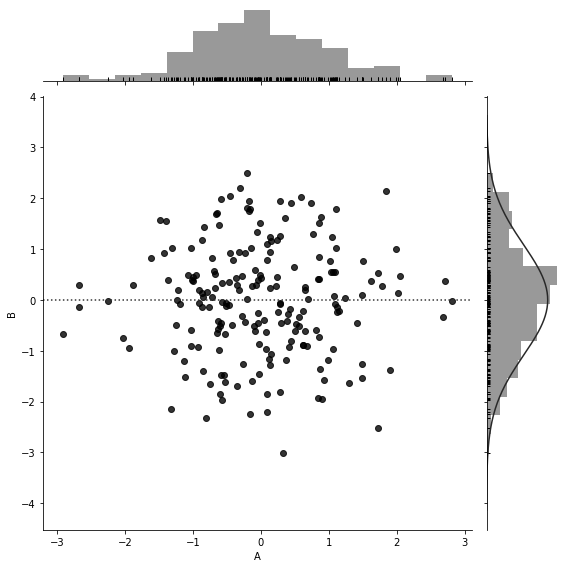
sns.jointplot(x=df['A'], y=df['B'],
data=df,
color='k',
kind='kde', #kde密度图
height=8,
ratio=5)
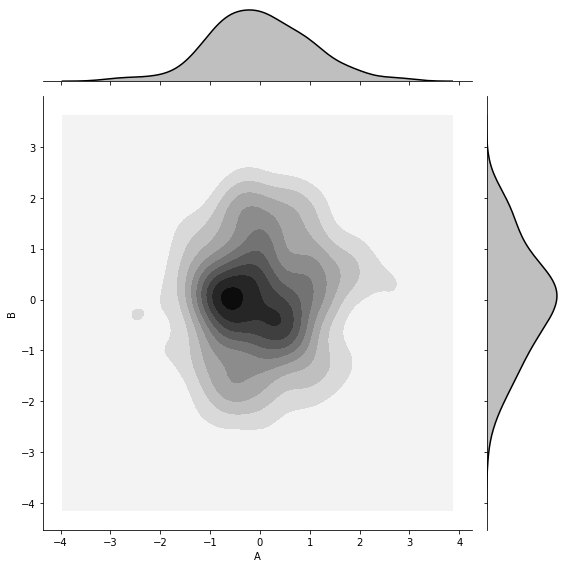
sns.jointplot(x=df['A'], y=df['B'],
data=df,
color='k',
kind='hex', #hex蜂窝图(六角形)
height=8,
ratio=5)
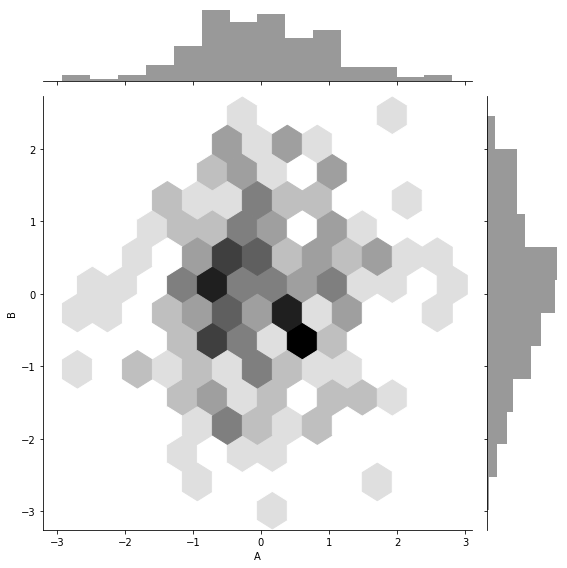
g = sns.jointplot(x=df['A'], y=df['B'],
data=df,
color='k',
kind='kde', #kde密度图
height=8,
ratio=5,
shade_lowest=False)
#添加散点图(c-->颜色,s-->大小)
g.plot_joint(plt.scatter, c='w', s=10, linewidth=1, marker='+')
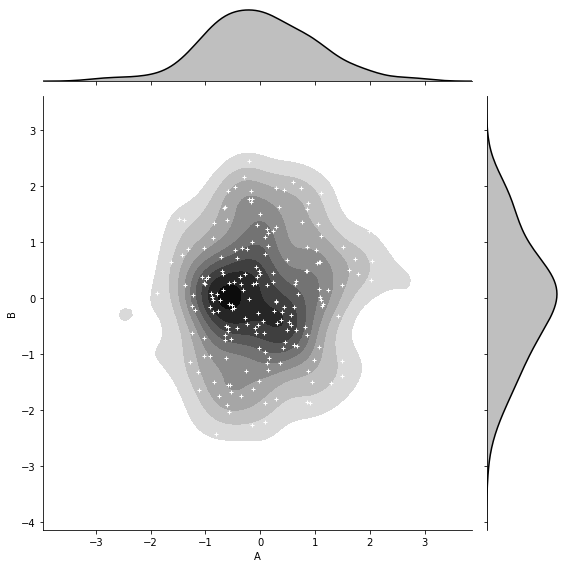
JointGrid()
创建图形网格,用于绘制二变量或单变量的图形,作用和Jointplot()一样,不过比Jointplot()更灵活。
sns.JointGrid(
x,
y,
data=None,
height=6,
ratio=5,
space=0.2,
dropna=True,
xlim=None,
ylim=None,
size=None,
)
Docstring: Grid for drawing a bivariate plot with marginal univariate plots.
Init docstring:
Set up the grid of subplots.
Parameters
----------
x, y : strings or vectors
Data or names of variables in ``data``.
data : DataFrame, optional
DataFrame when ``x`` and ``y`` are variable names.
height : numeric
Size of each side of the figure in inches (it will be square).
ratio : numeric
Ratio of joint axes size to marginal axes height.
space : numeric, optional
Space between the joint and marginal axes
dropna : bool, optional
If True, remove observations that are missing from `x` and `y`.
{x, y}lim : two-tuples, optional
Axis limits to set before plotting.
See Also
--------
jointplot : High-level interface for drawing bivariate plots with
several different default plot kinds.
#设置风格
sns.set_style('white')
#导入数据
tip_datas = sns.load_dataset('tips', data_home='seaborn-data')
#绘制绘图网格,包含三部分:一个主绘图区域,两个边际绘图区域
g = sns.JointGrid(x='total_bill', y='tip', data=tip_datas)
#主绘图区域:散点图
g.plot_joint(plt.scatter, color='m', edgecolor='w', alpha=.3)
#边际绘图区域:x和y轴
g.ax_marg_x.hist(tip_datas['total_bill'], color='b', alpha=.3)
g.ax_marg_y.hist(tip_datas['tip'], color='r', alpha=.3,
orientation='horizontal')
#相关系数标签
from scipy import stats
g.annotate(stats.pearsonr)
#绘制表格线
plt.grid(linestyle='--')
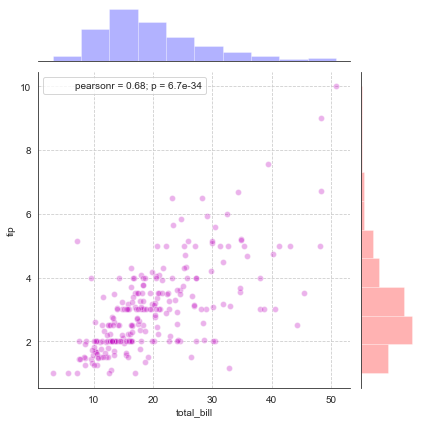
g = sns.JointGrid(x='total_bill', y='tip', data=tip_datas)
g = g.plot_joint(plt.scatter, color='g', s=40, edgecolor='white')
plt.grid(linestyle='--')
#两边边际图用统一函数设置统一风格
g.plot_marginals(sns.distplot, kde=True, color='g')
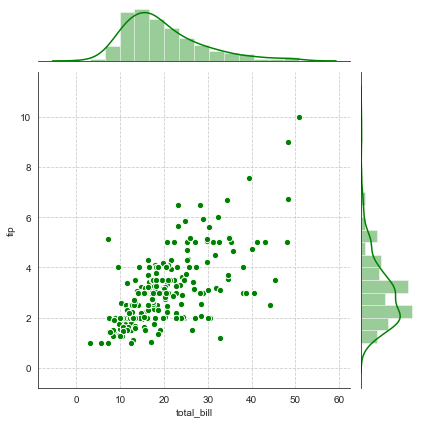
g = sns.JointGrid(x='total_bill', y='tip', data=tip_datas)
#主绘图设置密度图
g = g.plot_joint(sns.kdeplot, cmap='Reds_r')
plt.grid(linestyle='--')
#两边边际图用统一函数设置统一风格
g.plot_marginals(sns.distplot, kde=True, color='g')
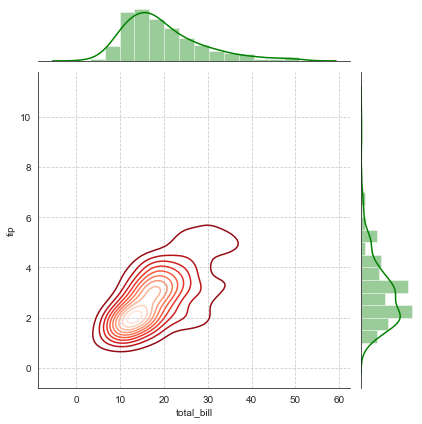
Pairplot()
用于数据集的相关性图形绘制,如:矩阵图,底层是PairGrid()。
sns.pairplot(
data,
hue=None,
hue_order=None,
palette=None,
vars=None,
x_vars=None,
y_vars=None,
kind='scatter',
diag_kind='auto',
markers=None,
height=2.5,
aspect=1,
dropna=True,
plot_kws=None,
diag_kws=None,
grid_kws=None,
size=None,
)
Docstring:
Plot pairwise relationships in a dataset.
By default, this function will create a grid of Axes such that each
variable in ``data`` will by shared in the y-axis across a single row and
in the x-axis across a single column. The diagonal Axes are treated
differently, drawing a plot to show the univariate distribution of the data
for the variable in that column.
It is also possible to show a subset of variables or plot different
variables on the rows and columns.
This is a high-level interface for :class:`PairGrid` that is intended to
make it easy to draw a few common styles. You should use :class:`PairGrid`
directly if you need more flexibility.
Parameters
----------
data : DataFrame
Tidy (long-form) dataframe where each column is a variable and
each row is an observation.
hue : string (variable name), optional
Variable in ``data`` to map plot aspects to different colors.
hue_order : list of strings
Order for the levels of the hue variable in the palette
palette : dict or seaborn color palette
Set of colors for mapping the ``hue`` variable. If a dict, keys
should be values in the ``hue`` variable.
vars : list of variable names, optional
Variables within ``data`` to use, otherwise use every column with
a numeric datatype.
{x, y}_vars : lists of variable names, optional
Variables within ``data`` to use separately for the rows and
columns of the figure; i.e. to make a non-square plot.
kind : {'scatter', 'reg'}, optional
Kind of plot for the non-identity relationships.
diag_kind : {'auto', 'hist', 'kde'}, optional
Kind of plot for the diagonal subplots. The default depends on whether
``"hue"`` is used or not.
markers : single matplotlib marker code or list, optional
Either the marker to use for all datapoints or a list of markers with
a length the same as the number of levels in the hue variable so that
differently colored points will also have different scatterplot
markers.
height : scalar, optional
Height (in inches) of each facet.
aspect : scalar, optional
Aspect * height gives the width (in inches) of each facet.
dropna : boolean, optional
Drop missing values from the data before plotting.
{plot, diag, grid}_kws : dicts, optional
Dictionaries of keyword arguments.
Returns
-------
grid : PairGrid
Returns the underlying ``PairGrid`` instance for further tweaking.
See Also
--------
PairGrid : Subplot grid for more flexible plotting of pairwise
relationships.
#导入鸢尾花数据
i_datas = sns.load_dataset('iris', data_home='seaborn-data')
i_datas
#矩阵散点图
sns.pairplot(i_datas,
kind='scatter', #图形类型(散点图:scatter, 回归分布图:reg)
diag_kind='hist', #对角线的图形类型(直方图:hist, 密度图:kde)
hue='species', #按照某一字段分类
palette='husl', #设置调色板
markers=['o','s','D'], #设置点样式
height=2) #设置图标大小
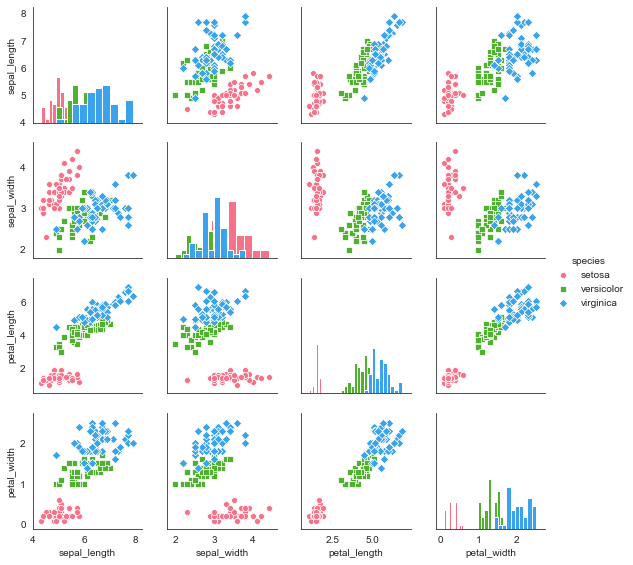
#矩阵回归分析图
sns.pairplot(i_datas,
kind='reg', #图形类型(散点图:scatter, 回归分布图:reg)
diag_kind='kde', #对角线的图形类型(直方图:hist, 密度图:kde)
hue='species', #按照某一字段分类
palette='husl', #设置调色板
markers=['o','s','D'], #设置点样式
height=2) #设置图标大小
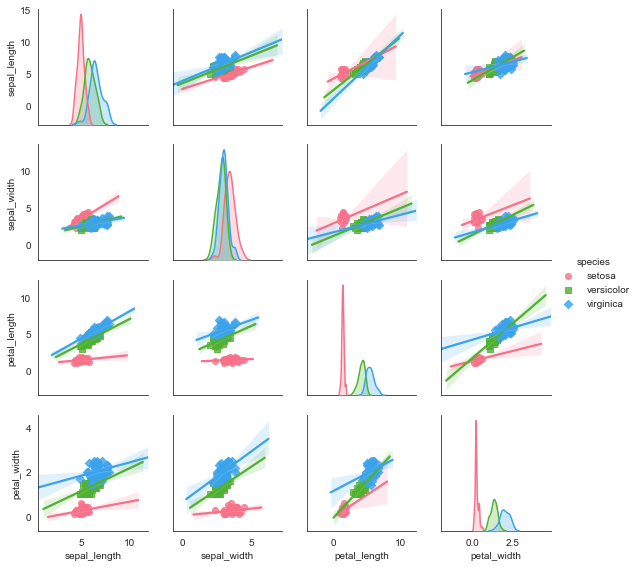
#局部变量选择,vars
g = sns.pairplot(i_datas, vars=['sepal_width', 'sepal_length'],
kind='reg', diag_kind='kde',
hue='species', palette='husl')
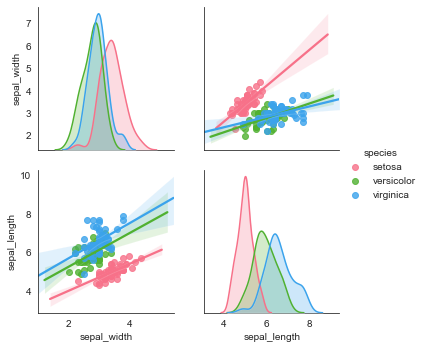
#综合参数设置
sns.pairplot(i_datas, diag_kind='kde', markers='+', hue='species',
#散点图的参数
plot_kws=dict(s=50, edgecolor='b', linewidth=1),
#对角线图的参数
diag_kws=dict(shade=True))
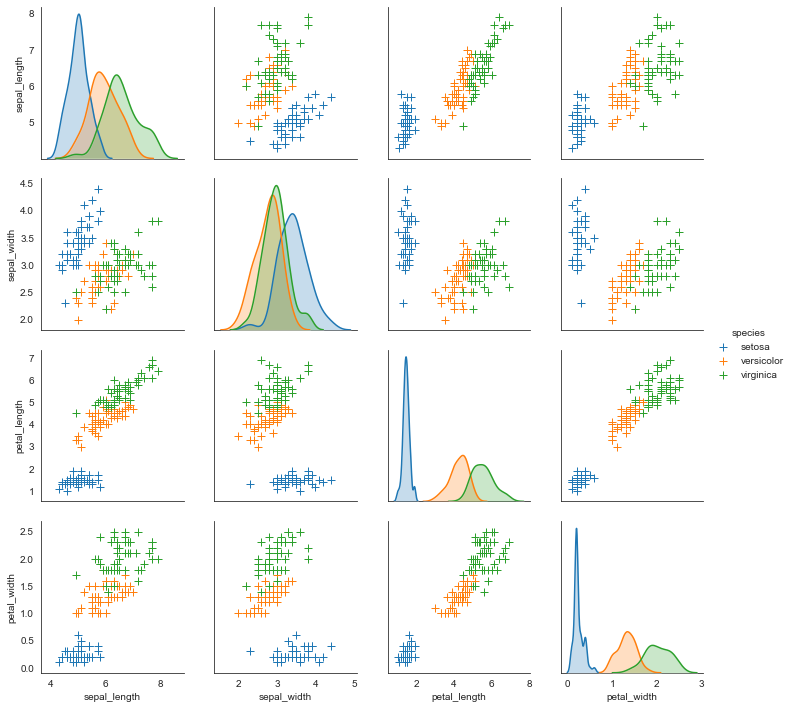
PairGrid()
用于数据集的相关性图形绘制,如:矩阵图。功能比Pairplot()更加灵活。
sns.PairGrid(
data,
hue=None,
hue_order=None,
palette=None,
hue_kws=None,
vars=None,
x_vars=None,
y_vars=None,
diag_sharey=True,
height=2.5,
aspect=1,
despine=True,
dropna=True,
size=None,
)
Docstring:
Subplot grid for plotting pairwise relationships in a dataset.
This class maps each variable in a dataset onto a column and row in a
grid of multiple axes. Different axes-level plotting functions can be
used to draw bivariate plots in the upper and lower triangles, and the
the marginal distribution of each variable can be shown on the diagonal.
It can also represent an additional level of conditionalization with the
``hue`` parameter, which plots different subets of data in different
colors. This uses color to resolve elements on a third dimension, but
only draws subsets on top of each other and will not tailor the ``hue``
parameter for the specific visualization the way that axes-level functions
that accept ``hue`` will.
See the :ref:`tutorial <grid_tutorial>` for more information.
Init docstring:
Initialize the plot figure and PairGrid object.
Parameters
----------
data : DataFrame
Tidy (long-form) dataframe where each column is a variable and
each row is an observation.
hue : string (variable name), optional
Variable in ``data`` to map plot aspects to different colors.
hue_order : list of strings
Order for the levels of the hue variable in the palette
palette : dict or seaborn color palette
Set of colors for mapping the ``hue`` variable. If a dict, keys
should be values in the ``hue`` variable.
hue_kws : dictionary of param -> list of values mapping
Other keyword arguments to insert into the plotting call to let
other plot attributes vary across levels of the hue variable (e.g.
the markers in a scatterplot).
vars : list of variable names, optional
Variables within ``data`` to use, otherwise use every column with
a numeric datatype.
{x, y}_vars : lists of variable names, optional
Variables within ``data`` to use separately for the rows and
columns of the figure; i.e. to make a non-square plot.
height : scalar, optional
Height (in inches) of each facet.
aspect : scalar, optional
Aspect * height gives the width (in inches) of each facet.
despine : boolean, optional
Remove the top and right spines from the plots.
dropna : boolean, optional
Drop missing values from the data before plotting.
See Also
--------
pairplot : Easily drawing common uses of :class:`PairGrid`.
FacetGrid : Subplot grid for plotting conditional relationships.
#绘制四个参数vars的绘图网格(subplots)
g = sns.PairGrid(i_datas, hue='species', palette='hls',
vars=['sepal_length', 'sepal_width', 'petal_length', 'petal_width'])
#对角线图形绘制
g.map_diag(plt.hist,
histtype='step', #可选:'bar'\ 'barstacked'\'step'\'stepfilled'
linewidth=1)
#非对角线图形绘制
g.map_offdiag(plt.scatter, s=40, linewidth=1)
#添加图例
g.add_legend()

g = sns.PairGrid(i_datas)
#主对角线图形
g.map_diag(sns.kdeplot)
#上三角图形
g.map_upper(plt.scatter)
#下三角图形
g.map_lower(sns.kdeplot, cmap='Blues_d')
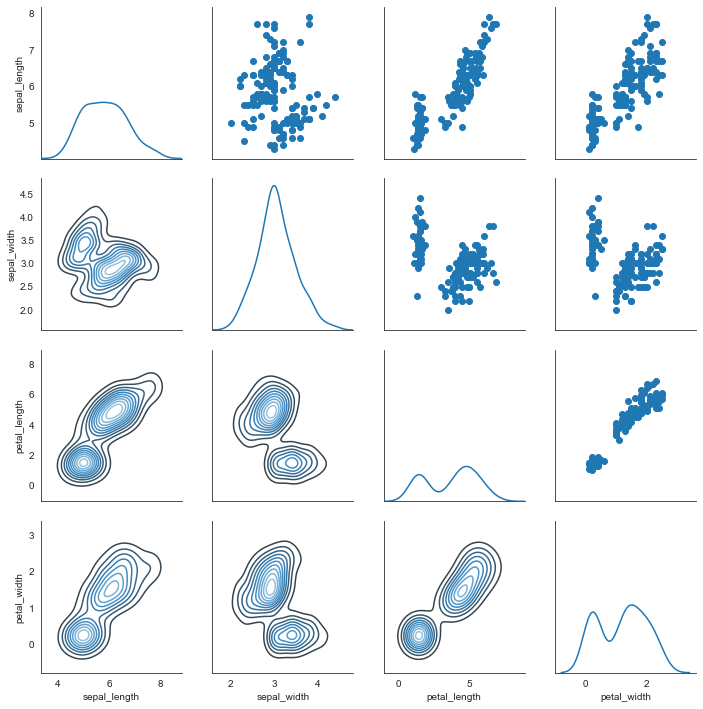
Seaborn分布数据可视化---散点分布图的更多相关文章
- seaborn分布数据可视化:直方图|密度图|散点图
系统自带的数据表格(存放在github上https://github.com/mwaskom/seaborn-data),使用时通过sns.load_dataset('表名称')即可,结果为一个Dat ...
- Python图表数据可视化Seaborn:1. 风格| 分布数据可视化-直方图| 密度图| 散点图
conda install seaborn 是安装到jupyter那个环境的 1. 整体风格设置 对图表整体颜色.比例等进行风格设置,包括颜色色板等调用系统风格进行数据可视化 set() / se ...
- Python图表数据可视化Seaborn:2. 分类数据可视化-分类散点图|分布图(箱型图|小提琴图|LV图表)|统计图(柱状图|折线图)
1. 分类数据可视化 - 分类散点图 stripplot( ) / swarmplot( ) sns.stripplot(x="day",y="total_bill&qu ...
- seaborn线性关系数据可视化:时间线图|热图|结构化图表可视化
一.线性关系数据可视化lmplot( ) 表示对所统计的数据做散点图,并拟合一个一元线性回归关系. lmplot(x, y, data, hue=None, col=None, row=None, p ...
- seaborn分类数据可视化
转载:https://cloud.tencent.com/developer/article/1178368 seaborn针对分类型的数据有专门的可视化函数,这些函数可大致分为三种: 分类数据散点图 ...
- seaborn分类数据可视化:散点图|箱型图|小提琴图|lv图|柱状图|折线图
一.散点图stripplot( ) 与swarmplot() 1.分类散点图stripplot( ) 用法stripplot(x=None, y=None, hue=None, data=None, ...
- 用seaborn对数据可视化
以下用sns作为seaborn的别名 1.seaborn整体布局设置 sns.set_syle()函数设置图的风格,传入的参数可以是"darkgrid", "whiteg ...
- Python Seaborn综合指南,成为数据可视化专家
概述 Seaborn是Python流行的数据可视化库 Seaborn结合了美学和技术,这是数据科学项目中的两个关键要素 了解其Seaborn作原理以及使用它生成的不同的图表 介绍 一个精心设计的可视化 ...
- Seaborn数据可视化入门
在本节学习中,我们使用Seaborn作为数据可视化的入门工具 Seaborn的官方网址如下:http://seaborn.pydata.org 一:definition Seaborn is a Py ...
- seaborn教程4——分类数据可视化
https://segmentfault.com/a/1190000015310299 Seaborn学习大纲 seaborn的学习内容主要包含以下几个部分: 风格管理 绘图风格设置 颜色风格设置 绘 ...
随机推荐
- pip相关知识
正常安装语法 # 安装单个 pip install some-package # 安装指定版本 pip install some-package==版本号 # 查看当前模块版本号 pip instal ...
- 一文搞懂I/O模型
目录 基础知识 内核 内核空间&用户空间 缓存IO 文件和流 文件描述符 I/O模型 同步阻塞 I/O(blocking IO) 同步非阻塞 I/O(blocking IO) I/O 多路复用 ...
- 可视化探索开源项目的 contributor 关系
引语:作为国内外最大的代码托管平台,根据最新的 GitHub 数据,它拥有超 372,000,000 个仓库,其中有 28,000,000 是公开仓.分布式图数据库 NebulaGraph 便是其中之 ...
- 测绘线性代数(四):数学期望、协方差、PCA
数学期望 E(X) = ∑pixi,X为所有xi的集合,pi为xi对应的概率. 通常来说,xi都是离散的,除非像高斯分布,假设xi不是离散的,才用上式. 当xi是离散的,那么: E(X) = 1 / ...
- SpringCloudStream消息驱动
1. 基本介绍 官方文档: https://spring.io/projects/spring-cloud-stream#learn 背景: 在一般的大型项目中,或者分布式微服务结构的系统里,一般都会 ...
- Java 从键盘读入学生成绩 找出最高分 并输出学生等级成绩 * 成绩>=最高分-10 等级为’A‘ * 成绩>=最高分-20 等级为’B‘ * 成绩>=最高分-30 等级为'C' * 其余 等级为’D‘
1 /* 2 * 从键盘读入学生成绩 找出最高分 并输出学生等级成绩 3 * 成绩>=最高分-10 等级为'A' 4 * 成绩>=最高分-20 等级为'B' 5 * 成绩>=最高分- ...
- 16 Educational Codeforces Round 142 (Rated for Div. 2)C. Min Max Sort(递归、思维、dp)
C. Min Max Sort 很不错的一道题目,不过脑电波和出题人每对上,\(qwq.\) 正难则反. 我们考虑最后一步是怎么操作的. 最后一步一定是对\(1\)和\(n\)进行操作 那么上一步呢? ...
- Zabbix6.0使用教程 (三)—zabbix6.0的安装要求
接上篇,我们继续为大家详细介绍zabbix6.0的使用教程之zabbix6.0的安装部署.接下来我们将从zabbix部署要求到四种不同的安装方式逐一详细的为大家介绍.本篇讲的是部署zabbix6.0的 ...
- 协议CAN&报文&仲裁
简介 物理层 CAN 协议提供了 5 种帧格式来传输数据 数据链路层 中数据帧和遥控帧有标准格式和扩展格式两种,标准格式有 11 位标识符(ID),扩展格式有 29 个标识符(ID) 显性0,隐性1 ...
- AMD Intel CPU 对比图
